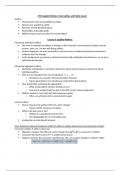MT3 Applied Welfare, Externalities and Public Goods
Outline
Measurement and recoverability of welfare
Special case: quasilinear utility
Elements of Cost-Benefit Analysis
Externalities and public goods
Welfare analysis and correction for market failure
Lecture 6: Applied Welfare
Measuring individual welfare
We want to evaluate the effects of changes in the consumer’s environment (change in prices,
income, taxes, etc.) on her well-being (utility).
Cardinal approach: we want to be able to say how much so ordinal framework of preference
relations won’t be enough.
In the background: we assume a rational consumer with well-behaved preferences, so we get a
well-behaved demand.
Measuring aggregate welfare
Normative individualism: normative statements about society based on statements about
individual welfare.
Who is to be included in the set of individuals 𝑖 = 1, … , 𝑛?
o All citizens of a country? All human beings? Animals?
o Future generations: how should you conduct time discounting?
How should their well-being be aggregated?
o What social welfare function should we use?
o How much weight should we put in the SWF on the various subgroups?
Welfare analysis is very hard with heterogeneous agents
o Often, we will work with a representative agent
Lecture outline
How to measure the welfare effect of a price change?
o Money-metric measures of welfare
What is the best way to tax?
o Welfare in a quasilinear environment
o The deadweight loss of commodity taxes
Introduction to Cost-Benefit Analysis
How should we measure changes in (indirect) utility or welfare when prices (and incomes) change?
Consumer welfare if utility is observed
Objective: measure the effect of a price change from 𝒑𝟎 to 𝒑𝟏 on consumer’s welfare.
Consumer has fixed income 𝑚 > 0, unaffected by prices.
Suppose we know the consumer’s preferences. We can compute changes in indirect utility:
o
, o Indirect utility function (𝑣) is obtained by substituting the demand function into the
utility function
Cobb-Douglas example
o
o If 𝜆 < 1 (if price decreases), 𝑣(𝒑𝟏, 𝑚) − 𝑣(𝒑𝟎, 𝑚) > 0 (indirect utility increases)
Money-metric measures of welfare
Problem: we don’t observe utility, utility is usually an ordinal concept, but we need a cardinal
measure.
So, we use money-metric measures of welfare constructed using the expenditure function.
Duality: uses 1-1 mapping between two problems.
o Duality is the principle that optimization problems may be viewed from either of two
perspectives, the primal problem or the dual problem.
o If the primal is a minimization problem, then the dual is a maximization problem (and
vice versa).
Primal problem: utility maximization
o Keep budget line (red) fixed and find the indifference curve (blue) furthest from the
origin with maximum utility
o Intermediate step: solve for the Marshallian demand function 𝒙*( 𝒑, 𝑚)
o Final step: obtain the indirect utility function 𝑣( 𝒑, 𝑚) by substituting Marshallian
demand function into the utility function.
o Result is maximised utility 𝑢 ̅
o
Dual problem: expenditure minimization
o Keep the indifference curve (blue) fixed and find the budget line (red) closes to the
origin to minimize expenditure
o Intermediate step: solve for the Hicksian demand function 𝒙* = ℎ( 𝒑, 𝑢 ̅)
o Final step: obtain the expenditure function 𝑒( 𝒑, 𝑢 ̅) by multiplying the Hicksian demand
function by price
o Result is minimised expenditure 𝑚
o
,
o Substituting expenditure function into Marshallian demand (LHS) gives the Hicksian
demand function (RHS)
Suppose there was a price change from 𝒑𝟎 to 𝒑𝟏 so the consumer’s indirect utility moves
from 𝑣(𝒑𝟎,𝑚) = 𝑢0 to 𝑣(𝒑𝟏,𝑚) = 𝑢1. How do we go from indirect utility to expenditure level?
For any arbitrary price vector 𝒑′, we measure:
o e(𝒑′,𝑢1) = expenditure needed to obtain utility level 𝑢1 when prices are 𝒑′
o e(𝒑′,𝑢0)
e(𝒑′,𝑢) is the money-metric utility function that is increasing in 𝑢
Measure of welfare change in money corresponding to price change:
o e(𝒑′,𝑢1)− e(𝒑′,𝑢0)
CV and EV
There are 2 natural reference points for 𝒑′ (𝒑𝟎 and 𝒑𝟏) leading to 2 measures of welfare
change
o Compensating Variation = addition to income required at new prices to maintain old
utility
o Equivalent Variation = addition to income required at old prices to reach new utility
o Change in demand (dark blue point) as price p 1 changes (gradient of black line changes)
o EV: at old prices (steeper gradient), additional income to reach the new utility (light blue
line tangent to the new indifference curve).
o CV: at new prices (gentler gradient), additional income needed to maintain the old
utility (red line tangent to the old indifference curve).
o EV and CV are the distance between the actual and hypothetical budget lines
o EV, CV aren’t directly observable, but are recoverable.
, Interpretation of EV and CV
o Interpretation of CV/EV depends on whether policy change is positive or negative (i.e.,
whether 𝑢1 > 𝑢0 or 𝑢1 < 𝑢0)
o
o Recall: normal goods have positive effect of income on demand
Example
Oxford pedestrian-only roads
o CV: How much would the city have to pay local businesses to keep them as well off as
they were before the road closure? (measure implemented)
o EV: What is the most that local businesses would be willing to pay to avoid the road
closure? (measure not implemented)
How much do you value the Internet?
o CV type: How much money would you require to stop using the Internet? ( 𝑊𝑇𝐴 for
negative change to be implemented)
o EV type: Giving up what good/activity would hurt you as much as losing the internet?
(𝑊𝑇𝑃 for negative change not to be implemented)
EV, CV and Hicksian demands
There is another graphical way of thinking about EV and CV
Take two normal goods 𝑥1, 𝑥2 and consider price change from 𝒑𝟎 to 𝒑𝟏 where the price of 𝑥1
decreases:
Recall: the expenditure function is equivalent to price multiplied by the Hicksian demand.
o
By the Envelope Theorem, only direct effects matter so:
o




